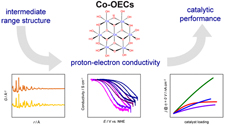Publication
872
ACS Appl. Energy Mater., 2 (1), 3-12, 2019
DOI:10.1021/acsaem.8b00785
|
|
|
|
|
|

|
Proton–Electron Conductivity in Thin Films of a Cobalt–Oxygen Evolving Catalyst
|
|
|
|
Casey N. Brodsky, D. Kwabena Bediako, Chenyang Shi, Thomas P. Keane, Cyrille Costentin, Simon J. L. Billinge, and Daniel G. Nocera
Department of Chemistry and Chemical Biology, Harvard University, 12 Oxford Street, Cambridge, Massachusetts 02138, United States
Department of Applied Physics and Applied Mathematics, Columbia University, New York, New York 10027, United States
Laboratoire d’Electrochimie Moléculaire and Unité Mixte de Recherche Université—CNRS No. 7591, Université Paris Diderot, Sorbonne Paris Cité, Bâtiment Lavoisier, 15 rue Jean de Baïf, 75205 Cedex 13 Paris, France
Condensed Matter Physics and Materials Science Department, Brookhaven National Laboratory, Upton, New York 11973, United States
The conductivities of thin film cobalt oxygen evolving catalysts (Co-OECs) are examined for four variants differing in phosphate and borate anion compositions and pH. The effects of these parameters on the Co-OEC activity is explored by (a) examination of the intermediate range structural order within films through high energy X-ray scattering and pair distribution function analysis, and (b) direct measurement of film conductivity, which has been measured with an interdigitated array microelectrode. We find that the nature of the anion is a critical determinant of the size of cobaltate clusters comprising the Co-OEC thin films which in turn is a critical determinant of film conductivity. Improved conductivity of the Co-OEC films with the size of the metalate clusters is consistent with a model for electron conduction that arises from the hopping of hole equivalents delocalized over metalate clusters. The hole hopping is fast relative to the rate-determining step of OER, which may become limited by proton transport within the films. |

